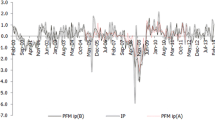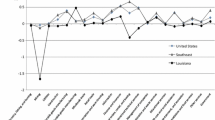Abstract
Petroleum production and exploration, used as petroleum industry indicators, and accumulation of petroleum-related geoscience literature, used as a science indicator, were compared by several means to gauge the degree of interaction between science and the industry in the period 1934–1990. Methods of comparison employed were: time domain correlations and crosscorrelation; correlations of spectra using coherence and crosspower spectra, and growth-modelling of the indicators. A fifty-year exploration cycle was found, beginning about 1945. Principal features of this cycle seem to coincide with prominent features in the time series for geoscience literature, and both of these variables are correlated with petroleum production. All three variables appear to have been determined ultimately by economic and political events which affected the petroleum industry. All of them show long-period cycles which coincide with the fourth Kondratiev cycle and the beginning of the fifth Kondratiev. The longest time series used (petroleum production in the United States, 1860–1990) shows long-period cycles matching the third, fourth and fifth Kondratiev cycles.
Similar content being viewed by others
Notes and references
D. H. Hall, The interface between geoscience and industry: a case study of the interaction between research and the discovery and mining of ores for nuclear fuels,Scientometrics, 11 (1987) 199–216.
The GEOREF database arose from printed publications as follows: 1785–1928:Geologic Literature on North America. Geological Society of America; 1929–1970:Bibliography of North American Geology. Geological Society of America; 1933–1968:Bibliography and Index of Geology Exclusive of North America. Geological Society of America and American Geological Institute; 1969-Present:Bibliography and Index of Geology. Geological Society of America and American Geological Institute. The GEOREF computer database includes the above as well as theBibliography and Index of Micropalaentology (1972-present),Geophysical Abstracts (1966–71), andBibliography of Theses in Geology (1965–66). The types of literature contained in the GEOREF database are: scientific articles in journals; government geological survey and research publications; conference proceedings; monographs; theses; guidebooks; lexicons; maps; atlases; bibliographies; and annual reports.
Sources of petroleum production, drilling and exploration data used: — Basic Petroleum Data Book, (American Petroleum Institute) Vol. XI, No. 2, May, 1991);
World Energy Supplies 1929–50;
Yearbook of World Energy Statistics, United Nations Statistics Office (published annually).
The correlation coefficient (c) ranges from 0 (uncorrelated) to +1 or −1 (perfect correlation or anti-correlation). For descriptive purposes the following ranges were adopted for c: 0–0.24, “uncorrelated”; 0.25–0.49, “poor”; 0.50–0.74, “good”; 0.75–1.00, “excellent”. For coherence we will use the scale: above 0.7, “excellent correlation”; 0.5–0.7, “good correlation”; below 0.5, “poor correlation”. For cohenrence we will use the scale: above 0.7, “excellent correlation”; 0.5–0.7, “good correlation”; below 0.5, “poor correlation”.
All calculations were done using the mathematical package MATLAB produced by The Math Works Inc. The mathematical methods used are described in an earlier paper (see note 16)D. H. Hall, The science-industry interface: correlation of time series of indicators and their spectra, and growth models in the nuclear fuels industry,Scientometrics, 24 (1992). Principal references are:S. James Press, Applied Multivariate Analysis, R. E. Krieger Pub. Co., Huntington, N. Y., 1982, pp. 64–67 (for the correlation matrix);J. S. Bendat, A. G. Piersol,Random Data (Analysis and Measurement Procedures), 2nd ed., Wiley, New York, 1986, pp. 270–273 (for crosscorrelation);G. U. Yule,An Introduction to the Theory of Statistics, C. Griffin and Co. Ltd, London, 1937 (for pitfalls in interpretation of correlation coefficients).A. V. Oppenheim, R. W. Shafer,Digital Signal Processing, Prentice-Hall, Engelwood Cliffs, N. J., 1975, pp. 553–4 orM. G. Kendall, A. S. Stuart,The Advanced Theory of Statistics, Vol. 3,Design and Analysis, and Time Series, Hafner Publishing Co., New York, 1966, pp. 454–459 (for calculation of spectra);E. R. Kanasewich,Time Sequence Analysis in Geophysics, 3rd ed., University of Alberta Press, Edmonton, 1981, pp. 132–137 (for coherence);A. Papoulis,The Fourier Integral and its Applications, McGraw-Hill, New York, 1962, pp. 252–320 (for calculation of spectra).
See pp. 49–53 in:D. Finch, Traces Through Time, Canadian Society of exploration geophysicists, Calgary, Canada, 1985, 192 p.
R. A. Simpson, Petroleum and Natural Gas in 1959,Canadian Mining Journal, February issue, 81 (1960) 163.
J. W. Frazer, Petroleum and Natural Gas in 1967,Canadian Mining Journal, February issue, 109 (1968) 156.
J. W. Frazer, Petroleum and Natural Gas in 1971,Canadian Mining Journal, February issue, 93 (1972) 153.
J. W. Frazer, Petroleum and Natural Gas in 1973,Canadian Mining Journal, February issue, 95 (1974) 139–40.
R. L. Thomas, Petroleum and Natural Gas in 1988,Canadian Mining Journal, February issue, 110 (1989) 68.
M. N. Cleary, G. D. Hobbs, (1984) the fifty year cycle: a look at the empirical evidence, in:C. Freeman (Ed.), Long Waves in the World Economy, London; Frances Pinter.
J. D. De Solla Price,Little Science, Big Science, Columbia University Press, 1963, 118 p. (Reprinted in Columbia Paperback Edition, 1965).S. S. Kuznets,Secular Movements in Production and Prices; Their Nature and Their Bearing upon Cyclical Fluctuations, New York; A. M. Kelley, 1967, 536 p.
H. W. Menard,Science: Growth and Change, Harvard University Press, 1971, Cambridge, Mass. p. 215.
D. H. Hall,History of the Earth Sciences during the Scientific and Industrial Revolutions, Elsevier Scientific Publishing Co., 1976, p. 297.
D. H. Hall, Rate of growth of science literature in geoscience from computerized databases,Scientometrics, 17 (1989) 15–38.
D. H. Hall, The science-industry interface: correlation of time series of indicators and their spectra, and growth models in the nuclear fuels industry,Scientometrics, 24 (1992).
See p. 573 in:R. Pearl,Studies in Human Biology, Baltimore, Williams & Wilkins Company, 1924, 653 p.
See p. 212 in:T. Davis,The Theory of Econometrics, The Principia Press Inc., Bloomington, Indiana, 482 p.
This follows definition (a) ofpetroleum, p. 469, and the definition ofnatural gas, p. 418, in:R. L. Bates, J. A. Jackson, (Eds)The Glossary of Geology, American Geological Institute, 1980.
C. Freeman (Ed.),Long Waves in the World Economy, London; Frances Pinter, 1984.
A. J. Nederhof, A. F. J. van Raan, A validation study of bibliometric indicators: the comparative performance of cum laude doctorates in chemistry,Scientometrics, 17 (1989) 427–435.
C. Freeman,Technology, Policy and Economic Performance, Pinter Publishers, London and New York, 1987, 155 p.
Author information
Authors and Affiliations
Rights and permissions
About this article
Cite this article
Hall, D.H. The science-industry interface in the petroleum industry: Correlation of time series of indicators and their spectra, and growth modelling. Scientometrics 28, 237–286 (1993). https://doi.org/10.1007/BF02026510
Received:
Issue Date:
DOI: https://doi.org/10.1007/BF02026510




